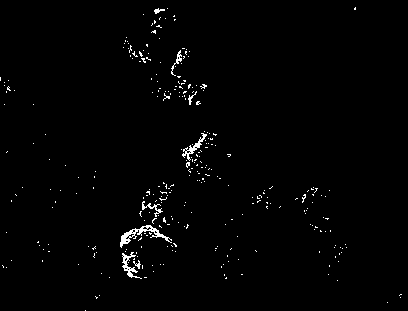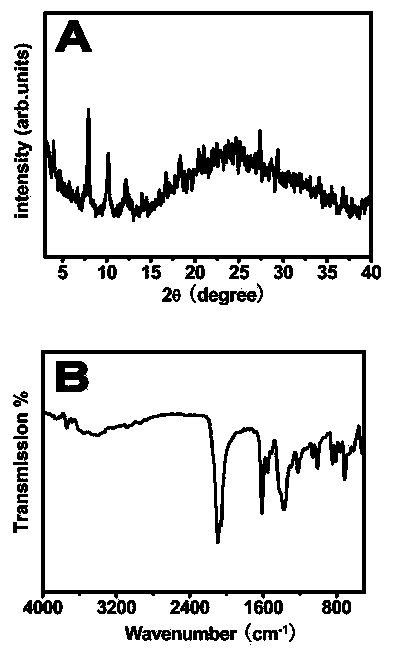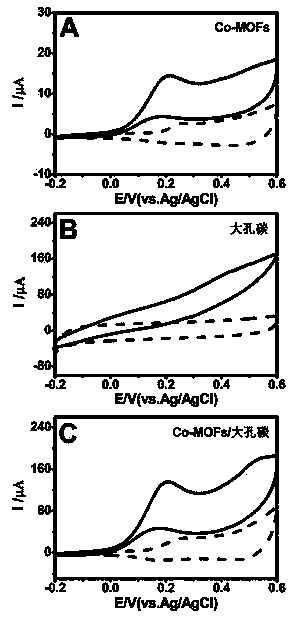Preparation method of cobalt metal organic frame/macroporous carbon compound
An organic framework, macroporous carbon technology, used in organic compound/hydride/coordination complex catalysts, electrolytic organic production, chemical instruments and methods, etc., to achieve excellent electrocatalytic activity, simple and safe preparation process, and avoid agglomeration. Effect
- Summary
- Abstract
- Description
- Claims
- Application Information
AI Technical Summary
Problems solved by technology
Method used
Image
Examples
Embodiment 1
[0016] The preparation method of Co-MOFs / macroporous carbon composite material of the present invention comprises the following steps:
[0017] Step 1: Add 50 mg of macroporous carbon to 20 mL of deionized water, and sonicate for 10 minutes (the power of the ultrasonic machine is 350 W).
[0018] Step 2: 95.2 mg cobalt chloride, 30 mg 5-(4-pyridyl) tetrazole, 40 mg 1,3-bis(4-pyridyl) propane and 66 mg sodium azide were added to the macroporous carbon In the dispersion, ultrasonic treatment was performed for another 10 minutes to make it fully mixed.
[0019] Step 3: Transfer the mixture dispersion to a hydrothermal reaction kettle, react at 160°C for 72 hours, and then cool to room temperature naturally.
[0020] Step 4: After the obtained product was centrifuged at high speed (8000 rpm), washed three times with deionized water, and then dried in vacuum at 50 °C for 24 hours to obtain the Co-MOFs / macroporous carbon composite material. figure 1 It is the scanning electron mic...
Embodiment 2
[0022] The preparation method of Co-MOFs / macroporous carbon composite material of the present invention comprises the following steps:
[0023] Step 1: Add 20 mg of macroporous carbon into 20 mL of deionized water, and sonicate for 10 minutes (the power of the ultrasonic machine is 350 W).
[0024] Step 2: 95.2 mg cobalt chloride, 30 mg 5-(4-pyridyl) tetrazole, 40 mg 1,3-bis(4-pyridyl) propane and 66 mg sodium azide were added to the macroporous carbon In the dispersion, ultrasonic treatment was performed for another 10 minutes to make it fully mixed.
[0025] Step 3: The mixture dispersion was transferred to a hydrothermal reaction kettle, and after reacting for 72 hours at 140° C., it was naturally cooled to room temperature.
[0026] Step 4: After the obtained product was centrifuged at high speed (8000 rpm), washed three times with deionized water, and then dried in vacuum at 70 °C for 24 hours to obtain the Co-MOFs / macroporous carbon composite material.
Embodiment 3
[0028] The preparation method of Co-MOFs / macroporous carbon composite material of the present invention comprises the following steps:
[0029] Step 1: Add 80 mg of macroporous carbon to 20 mL of deionized water, and sonicate for 10 minutes (the power of the ultrasonic machine is 350 W).
[0030] Step 2: 95.2 mg cobalt chloride, 30 mg 5-(4-pyridyl) tetrazole, 40 mg 1,3-bis(4-pyridyl) propane and 66 mg sodium azide were added to the macroporous carbon In the dispersion, ultrasonic treatment was performed for another 10 minutes to make it fully mixed and uniform.
[0031] Step 3: The mixture dispersion was transferred to a hydrothermal reaction kettle, and after reacting for 70 hours at 150° C., it was naturally cooled to room temperature.
[0032] Step 4: After the obtained product was centrifuged at high speed (8000 rpm), washed three times with deionized water, and then dried in vacuum at 60 °C for 24 hours to obtain the Co-MOFs / macroporous carbon composite material.
PUM
 Login to View More
Login to View More Abstract
Description
Claims
Application Information
 Login to View More
Login to View More - R&D
- Intellectual Property
- Life Sciences
- Materials
- Tech Scout
- Unparalleled Data Quality
- Higher Quality Content
- 60% Fewer Hallucinations
Browse by: Latest US Patents, China's latest patents, Technical Efficacy Thesaurus, Application Domain, Technology Topic, Popular Technical Reports.
© 2025 PatSnap. All rights reserved.Legal|Privacy policy|Modern Slavery Act Transparency Statement|Sitemap|About US| Contact US: help@patsnap.com



